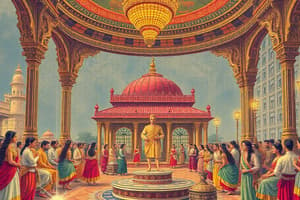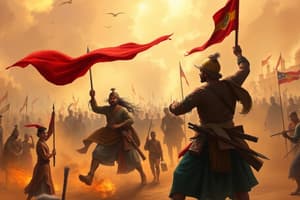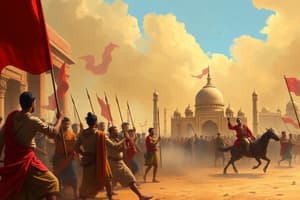Podcast
Questions and Answers
What was the primary economic grievance that contributed to the Indian Revolt of 1857?
What was the primary economic grievance that contributed to the Indian Revolt of 1857?
The East India Company's drain of India's wealth and exploitation of Indian resources.
What was the immediate cause of the Indian Revolt of 1857?
What was the immediate cause of the Indian Revolt of 1857?
The refusal of Indian soldiers to use greased cartridges at Meerut.
Who was proclaimed the Emperor of India during the Indian Revolt of 1857?
Who was proclaimed the Emperor of India during the Indian Revolt of 1857?
Bahadur Shah Zafar, the last Mughal Emperor.
What was the consequence of the British suppression of the Indian Revolt of 1857?
What was the consequence of the British suppression of the Indian Revolt of 1857?
What was the significance of the Government of India Act, 1858?
What was the significance of the Government of India Act, 1858?
Who led the revolt in Lucknow during the Indian Revolt of 1857?
Who led the revolt in Lucknow during the Indian Revolt of 1857?
What was a key social and cultural grievance that contributed to the Indian Revolt of 1857?
What was a key social and cultural grievance that contributed to the Indian Revolt of 1857?
What was the significance of the Indian Revolt of 1857 in the context of Indian independence?
What was the significance of the Indian Revolt of 1857 in the context of Indian independence?
What was the main reason behind the resentment among Indian princes and nobles?
What was the main reason behind the resentment among Indian princes and nobles?
What was the incident that sparked the Indian Rebellion of 1857?
What was the incident that sparked the Indian Rebellion of 1857?
Who led the rebels in Cawnpore during the Indian Rebellion of 1857?
Who led the rebels in Cawnpore during the Indian Rebellion of 1857?
What was the outcome of the British suppression of the Indian Rebellion of 1857?
What was the outcome of the British suppression of the Indian Rebellion of 1857?
Who led the British forces during the siege of Lucknow?
Who led the British forces during the siege of Lucknow?
What was the consequence of the introduction of the Enfield rifle?
What was the consequence of the introduction of the Enfield rifle?
Who was the Queen of Jhansi who led the rebels?
Who was the Queen of Jhansi who led the rebels?
What was the significance of the Delhi Siege?
What was the significance of the Delhi Siege?
Flashcards are hidden until you start studying
Study Notes
Causes of the Revolt
- Economic exploitation: East India Company's drain of India's wealth and exploitation of Indian resources
- Social and cultural reforms: Interference in Indian social and cultural practices, such as the abolition of sati and the introduction of English education
- Political grievances: Annexation of Indian states, removal of pensions of Indian rulers, and the Doctrine of Lapse
- Military grievances: Discrimination against Indian soldiers, poor pay, and poor living conditions
Events of the Revolt
- May 10, 1857: Indian soldiers (sepoys) at Meerut refused to use greased cartridges, leading to their imprisonment and sparking the revolt
- Delhi: Bahadur Shah Zafar, the last Mughal Emperor, was proclaimed the Emperor of India
- Kanpur: Nana Sahib, a Maratha leader, led the revolt in Kanpur
- Lucknow: The revolt was led by Begum Hazrat Mahal, the wife of the deposed Nawab of Awadh
- Jhansi: Rani Lakshmibai, the queen of Jhansi, led the revolt in Jhansi
Key Figures
- Mangal Pandey: A sepoy who attacked British officers, sparking the revolt
- Bahadur Shah Zafar: The last Mughal Emperor, who was proclaimed the Emperor of India during the revolt
- Nana Sahib: A Maratha leader who led the revolt in Kanpur
- Rani Lakshmibai: The queen of Jhansi, who led the revolt in Jhansi
- Begum Hazrat Mahal: The wife of the deposed Nawab of Awadh, who led the revolt in Lucknow
Consequences of the Revolt
- Suppression of the Revolt: The British eventually suppressed the revolt, leading to the execution or exile of Indian leaders
- End of the East India Company: The British government abolished the East India Company and took direct control of India
- Government of India Act, 1858: The Act established the British Raj in India, with the Viceroy as the head of the government
- Indian Rebellion: The revolt marked a turning point in the Indian struggle for independence
Causes of the Revolt
- Economic exploitation of India's wealth and resources by the East India Company
- Interference in Indian social and cultural practices, such as the abolition of sati and introduction of English education
- Political grievances including annexation of Indian states, removal of pensions of Indian rulers, and the Doctrine of Lapse
- Military grievances including discrimination against Indian soldiers, poor pay, and poor living conditions
Events of the Revolt
- May 10, 1857: Indian soldiers (sepoys) at Meerut refused to use greased cartridges, leading to their imprisonment and sparking the revolt
- Delhi: Bahadur Shah Zafar, the last Mughal Emperor, was proclaimed the Emperor of India
- Kanpur: Nana Sahib, a Maratha leader, led the revolt in Kanpur
- Lucknow: The revolt was led by Begum Hazrat Mahal, the wife of the deposed Nawab of Awadh
- Jhansi: Rani Lakshmibai, the queen of Jhansi, led the revolt in Jhansi
Key Figures
- Mangal Pandey: A sepoy who attacked British officers, sparking the revolt
- Bahadur Shah Zafar: The last Mughal Emperor, who was proclaimed the Emperor of India during the revolt
- Nana Sahib: A Maratha leader who led the revolt in Kanpur
- Rani Lakshmibai: The queen of Jhansi, who led the revolt in Jhansi
- Begum Hazrat Mahal: The wife of the deposed Nawab of Awadh, who led the revolt in Lucknow
Consequences of the Revolt
- The British eventually suppressed the revolt, leading to the execution or exile of Indian leaders
- The East India Company was abolished, and the British government took direct control of India
- The Government of India Act, 1858, established the British Raj in India, with the Viceroy as the head of the government
- The revolt marked a turning point in the Indian struggle for independence
Causes of the Rebellion
- Social and religious policies of the British East India Company threatened traditional Indian customs and religions, leading to widespread resentment.
- The introduction of the Enfield rifle, which required soldiers to bite the cartridge, offended both Hindu and Muslim soldiers.
- The British abolished the Mughal Empire and exiled the last Mughal emperor, Bahadur Shah II.
- Economic exploitation by the British led to economic hardship and poverty.
- The British East India Company's monopoly on trade and industry led to the decline of Indian industries.
- The introduction of the Doctrine of Lapse allowed the British to annex Indian states, leading to widespread discontent.
- Resentment among Indian princes and nobles grew due to the British East India Company's expansionist policies and annexation of Indian states.
Events of the Rebellion
- The Meerut Mutiny, led by Mangal Pandey, took place on May 10, 1857, where Indian soldiers rebelled against their British officers.
- The rebels, led by Bahadur Shah II, captured Delhi and declared him the Emperor of India.
- The Cawnpore Massacre occurred in June 1857, where British women and children were killed by the rebels.
- The Lucknow Siege saw the British, led by Sir Henry Lawrence, besieged by the rebels.
- The British, led by General Colin Campbell, eventually suppressed the rebellion, capturing Delhi and Lucknow.
Key Figures
- Mangal Pandey: Led the Meerut Mutiny.
- Bahadur Shah II: Last Mughal Emperor, declared Emperor of India by the rebels.
- Nana Sahib: Maratha nobleman who led the rebels in Cawnpore.
- Rani Lakshmibai: Queen of Jhansi, led the rebels in Jhansi.
- Sir Henry Lawrence: British general who led the British forces during the siege of Lucknow.
Consequences of the Rebellion
- The rebellion marked the end of the Mughal Empire and the beginning of British rule in India.
- The Government of India Act was passed, transferring the administration of India from the British East India Company to the British Crown.
- The Indian Army was reorganized, creating a more centralized and disciplined force.
- Increased British investment in India followed, particularly in the development of infrastructure and industries.
Studying That Suits You
Use AI to generate personalized quizzes and flashcards to suit your learning preferences.




